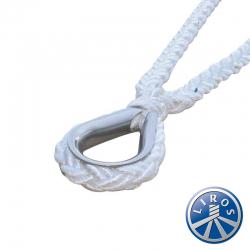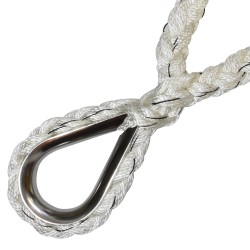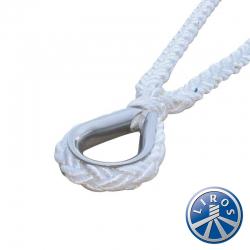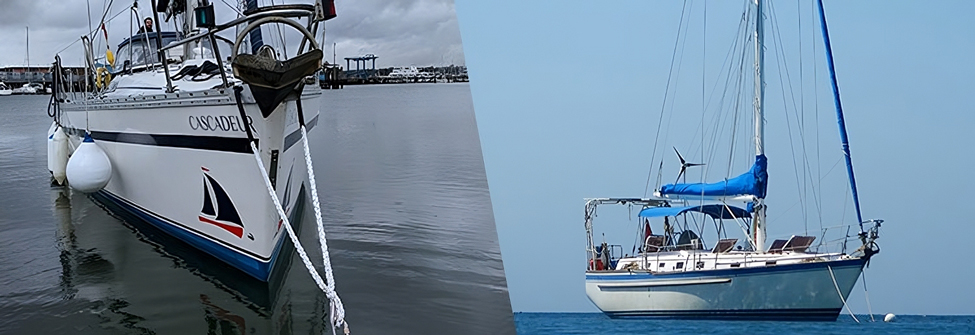
V-shaped bridles are an innovative, effective method of overcoming mooring and anchoring headaches. V-bridles are a simple but extremely beneficial concept. When specified and produced accurately, they are manageable and the antithesis of cumbersome.
What is a V-Shaped Bridle?
A V-shaped bridle is a simple but effective idea introduced to yachting by Mike Green in the early days of Jimmy Green Marine, when 8 strand square braided lines first came onstream from prominent yacht rope manufacturers.
A V-Bridle is formed into a V shape with a central loop or hard eye at the apex from one continuous length of rope, creating two legs (or tails). The two tails are usually equal in length for symmetry but can be different lengths to account for variations in deck layout or to offset the load.
The Jimmy Green Anchorplait® Centre Eye Splice, with or without a thimble included, forms the apex of the V-bridle
The two tails of the bridle can be made to any required length and finished with a suitable splice or whipping.
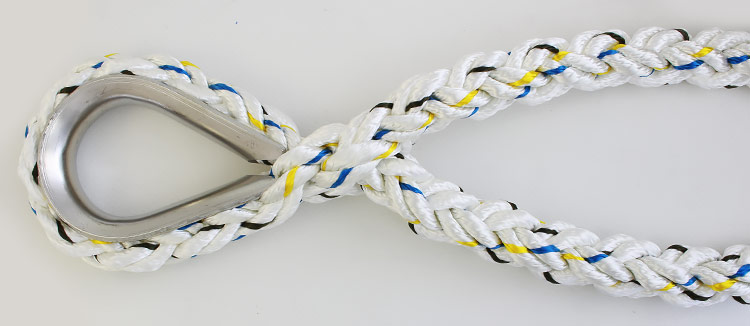
Is a V-Bridle Strong?
There are two main reasons why a Jimmy Green Anchorplait® V-bridle is extraordinarily strong:
- The critical element of the centre eye splice is that it is produced from one length of rope with no breaks or joins – the soft loop or hard thimble eye is completed with a Brummel locking tuck splice - the locking feature is fundamental to the security of the centre eye splice.
- The Jimmy Green Anchorplait® Brummel Lock Centre Eye Splice will maintain a notably high percentage of the original break load of the line because the Jimmy Green Rigging Team are trained to ensure that all the strands maintain their optimum flow throughout the splice. Maximum tensile strength is retained when all the strands are settled back into their natural structure to take the strain equally and as longitudinally as practicable.
Is Splicing Two Ropes Together a Good Idea?
Joining two ropes to make a bridle is not, generally speaking, a prudent idea. A splice that joins two separate lines, effectively creating a >- forked connection, is conceivably the weakest and least reliable of all splices.
Even at the optimum angle, where the standing part is in full tension, the splice may part far too easily. And as the angle between the joining line and the standing part becomes obtuse, the splice will be compromised to an even greater extent.
V-Bridle Rope and Splicing Construction
Anchorplait®, also known as Octoplait or Squareline, is a rope designed and manufactured with eight strands in four equal pairs, two pairs in a left-hand lay (twist) and two pairs in a right-hand lay. This construction creates a flexible, balanced, stable rope that is resistant to twist and ideal for the centre eye splice. The Jimmy Green method is ingenious, utilising the square braiding structure to create a robust, secure, and enduring splice.
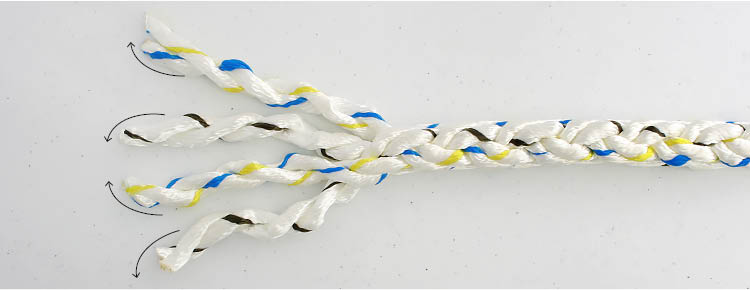
Important Note: The odd number of strands makes it impossible to put a worthwhile centre-eye splice in a twisted lay, three-strand rope.
V-Bridle Principles
Consider the geometrical relationship between the apex (centre eye splice) and the ends of the two tails with care. If the angle is too open, there will be too much lateral strain on the rope and the centre eye splice. Ropes are manufactured to perform well in a straight pull but are susceptible to sharp turns or kinks, so the best set-up will enable the rope to take a natural direction as it emerges from the splice.
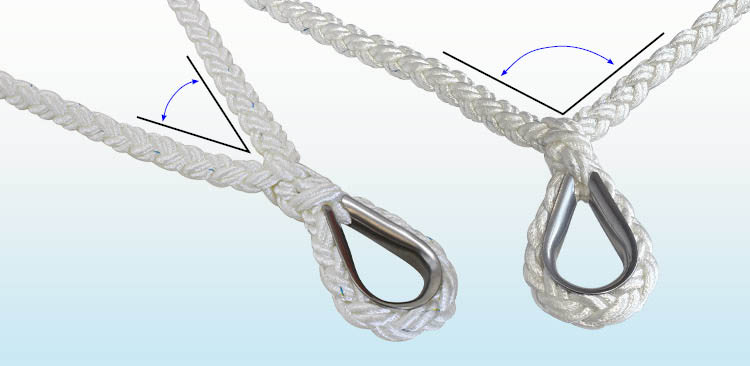
LHS – the lines emerge from the splice in as natural a direction as possible.
RHS – Too wide an angle will cause excessive load on the line and the splice.
The Advantages of a V-Bridle over a Single Line
The V-Bridle comes into its own when a single load needs to be divided between two attachment points. Join the centre eye splice (apex of the V) to a chain, warp, mooring buoy or any other attachment point. Make the two tails off to two separate cleats or bollards. At the bow and stern of a yacht, the port and starboard mooring cleats and fairleads can be brought into play, preventing a logjam down the centreline.
Looking forward, the bow roller will almost certainly be occupied with anchor chain and warp, whereas the mooring cleats will not. Looking aft, a single line may foul the rudder or steering position and the mooring cleats are usually fitted on the stern quarter.
The Advantages of a V-bridle over Two Separate Lines
A V-Bridle is simply more compact and less clunky, with one thimble and joining shackle instead of two.
Where Two Lines may be Preferable
Two lines may be necessary for mooring and anchoring a multihull because the angle may be too wide for a V-Bridle to take the load appropriately. Although making the tails longer will close the angle, this may not be practicable because of the increased radius of the swinging circle.
V-Bridle Applications
These are the main applications for V-Bridles, although, with a little ingenuity, there could be more.
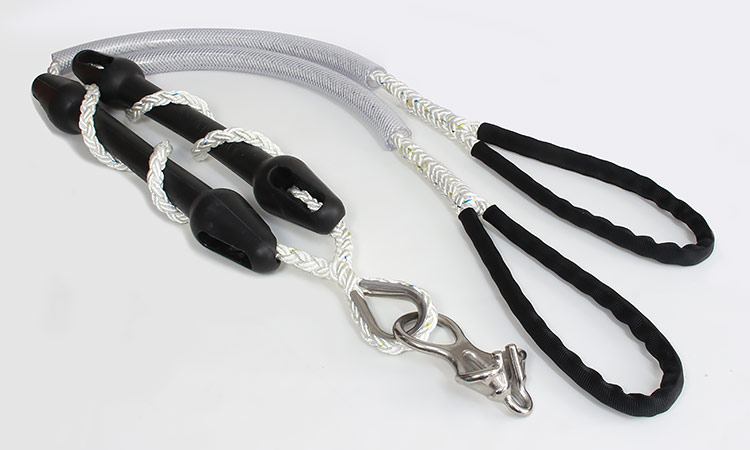
Anchor Chain Snubbing V-Bridles
Chain Snubbing Lines transfer the load from your windlass to a deck cleat or strongpoint while riding to the anchor on a chain-only rode. The elasticity in the nylon helps to absorb shock loads and smooth out any snatches and jerks caused by the wind and sea state. The longer the line, the more it will stretch and smooth out the movement.
There is no point in over-specifying a snubbing line because that will reduce the amount it will stretch. Something comparable to your bower anchor warp or compatible with your anchor chain size is going to be about right. By the same token, an under-specified snubbing line will have more springiness, but the load may ultimately prove too much. Remember, too, that mooring compensators are excellent for adding extra elasticity.
N.B. The windlass clutch and gearbox are not designed to absorb snatch loads, so it is essential to make the chain fast to a cleat or secure in a chain stopper just in case the snubbing line does part in adverse conditions.

Adding a chain hook, gripper or grab onto the centre eye splice of the V-Bridle makes it simple to engage and disengage the chain.
Lead the tails (legs) of the bridle back through the forward fairleads, one on each side, and make them off on the port and starboard deck cleats.
The tails can be finished at a fixed length with a spliced loop for lassoing over a cleat or extended in length with whipped ends for adjustment. The length that you deploy may vary according to the duration at anchor and whether the crew are onboard. It will be good practice to mark the lines to ensure that the load is not offset.
A Note on Single-Line Chain Snubbing -
As a short-term solution, you can lead a single snubbing line over the bow roller if it is free and accessible. As a temporary measure, even though the strain will be offset, which may affect the ride to anchor, a snubbing line can also be deployed through a forward mooring fairlead. For long-term or live-aboard anchoring, especially uncrewed, the bow roller may not be a suitable solution. The channel may be too narrow, causing chafing or snarling issues. A single line will work well If the bow roller route is available and trouble-free, but a V-Bridle pre-empts any issues with the bow roller.

Mooring V-Bridles for a Swinging Mooring or a Trot
A single Anchorplait® strop to a buoy with substantial chafe protection is a common and perfectly adequate method of setting up a swinging mooring. However, if the stemhead fitting and the bow roller are already occupied, and you have suitable port and starboard fairleads and deck cleats, a V-bridle will be an excellent alternative.
You will need symmetrical tails and, crucially, the same diameter Anchorplait® as would be specified for a single-line mooring strop.
Specify the same Anchorplait® Diameter as a Single-Line Mooring Strop
The load is theoretically shared between the two tails. However, as the wind shifts and the yacht veers, one tail will take increasingly more of the strain as the other tail goes slack. At that point, the loaded tail may take 100% of the strain until the yacht starts to veer back and start transferring the strain back to the opposite tail. As the wind oscillates, the yacht will veer back and forth and rarely be truly head to wind for sustained periods.

Yacht Drogue or Parachute Anchor Deployment and Towing Warp Attachment
There is seldom a suitable cleat positioned on the centre line at the stern, so making a single line fast on the transom may not be an option. Instead, the stern quarter mooring cleats will suit the V-bridle attachment admirably, preventing any interference with the rudder, tiller, or steering position. This arrangement may also prevent fouling the propeller.
According to sea conditions, it may be helpful to adjust the length of the tails to offset the warp when towing or deploying a yacht drogue from the stern. A V-bridle will also have a stabilising influence on the towing or drogue warp.
The same principles and advantages apply for parachute anchor deployment as for chain snubbing, N.B. a stronger bridle may be desirable to cope with severe weather conditions for this application.
Main Menu
Main Menu
Back
Main Menu
Back
Main Menu
Back
Back
Main Menu
Back
Main Menu
Back
Back
Main Menu
Back
Main Menu
Main Menu
Back
Main Menu
Back
Back
Back
Back
Back
Back
Back
Back





















